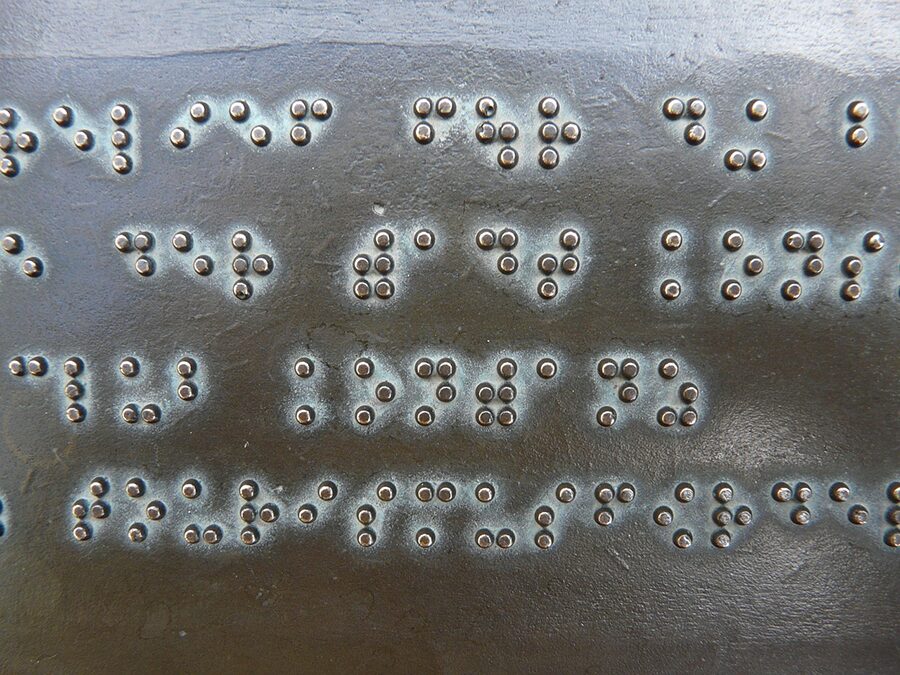In publishing—at least here at Ooligan Press—we talk a lot about accessibility, and so I thought it might be helpful to give a bit of an inside look into what it looks like to use accessibility tools from a reader’s perspective.
I was born legally blind. What that means for me is that I have never been able to see what a sighted person sees. I have some residual vision. In the blind and low vision community, this makes me a “partial,” which can be taken to mean either partially sighted or partially blind.
What this means for me as a reader is that I use a variety of ways of accessing books: reading print books at regular print sizes at a very close distance, reading large print books, and listening to audiobooks. My childhood was full of “Talking Books” (part of the National Library Service). They arrived as boxes of tapes, and I played them on a special NLS cassette player. Large Print books arrived in cloth mailers, and we won’t talk about the time I was accidentally sent the V.C. Andrews book My Sweet Audrina when I was a very sheltered twelve-year-old.
There are a whole host of ways for blind and low vision readers to access books, whether that’s adjusting font size, or a whole host of programs to access audiobooks. Nowadays, not surprisingly, NLS has an app (BARD Mobile), and I often access audiobooks there, as well as through typical channels like Libby and occasionally Audible.
When in a pinch—there’s a long wait on Libby, BARD Mobile isn’t the fastest at acquiring books and often doesn’t have new releases, you’ve canceled Audible for the 57th time in an attempt to save money—there are other options. Most of these involve being read to by a computer by using a screen reader. As an Apple user who will never change because they have the best accessibility features by far, that screen reader is VoiceOver, which comes on all Apple devices and computers. By using VoiceOver, you can have Siri read any book in your Books app, and I may have once upon a time used this to read all of the Pretty Little Liars books in the span of a week or two.
Of course, the blind and low vision community isn’t a monolith, but in my experience, a fair number of us are big readers. In large part, this is likely because there are so many different ways to access books. We grew up with ample access—even people as old as me who grew up a few decades back—and we got used to listening to and interacting with computerized voices.
One thing that can present more of a challenge than reading itself is finding out about books and interacting with the websites and apps where people are talking about books. A lot of this happens on social media, and some platforms are more accessible than others.
As one example, Twitter used to be my go-to, as it depended least on visual imagery and had plenty of readers and book lovers and publishers. It was easy to access and absorb the conversations and participate. A lot of users included alt-text for their images or GIFs, and though it sometimes wasn’t ideal (e.g. the alt-text for a GIF just says “GIF”), now that it’s X, the accessibility team was let go. Coming across alt-text now feels so rare it’s like a Sasquatch sighting, and it’s no longer the book lovers haven it used to be. A lot of blind and low vision readers are still mostly using Facebook as their social media site of choice.
These days I have a lot of sources for book news, like Goodreads email newsletters or simply going on Goodreads and looking at what friends are reading, other bookish email announcements, and word of mouth. But, like a lot of people, I mostly get my book news through Instagram by following lots of bookstores, publishers, authors, book reviewers, and so on.
Instagram can be challenging for us visually impaired folks because it is so visual, and not everyone uses alt-text. The app—and this is true of many apps—doesn’t play as well with accessibility features as web browsers do, and won’t enlarge the screen with a hand gesture. So, it has its accessibility barriers. But it’s still my current go-to.
In addition to using alt-text, another option I sometimes see is an image description written in the caption. This is helpful for people using screen readers and also for people like me who might be accessing Instagram visually but unable to see a lot of the details in images. One exemplary account that does both alt-text and image descriptions, and just generally has great book and publishing content, is Indigo: Editing, Design, and More (@indigobookediting).
Remembering to include alt-text and/or image descriptions in digital and online content isn’t just a nice thing to do, and it isn’t even just about accessibility. It’s also about marketing, reaching a large community of readers and potential book buyers who have plentiful ways to access books, but might not have as much access to finding out about them.

